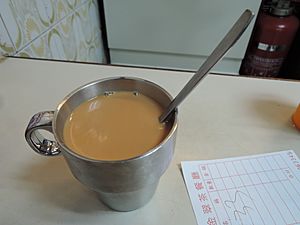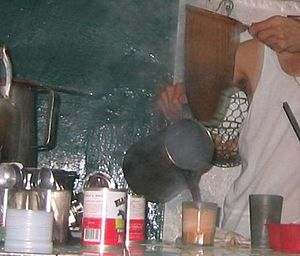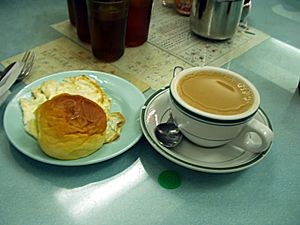Hong Kong–style milk tea facts for kids

Hot milk tea
|
|
| Course | Drink |
|---|---|
| Place of origin | Hong Kong |
| Serving temperature | Hot or iced |
| Main ingredients | Ceylon tea, evaporated, condensed milk, sugar |
| Similar dishes | |
| Hong Kong–style milk tea | |||||||||||||
|---|---|---|---|---|---|---|---|---|---|---|---|---|---|
| Chinese | 港式奶茶 | ||||||||||||
| Cantonese Yale | Góngsīk náaihchà | ||||||||||||
| Literal meaning | Hong Kong–style milk tea | ||||||||||||
|
|||||||||||||
| Alternative Chinese name | |||||||||||||
| Chinese | 香港奶茶 | ||||||||||||
| Cantonese Yale | Hēunggóng náaihchà | ||||||||||||
| Literal meaning | Hong Kong milk tea | ||||||||||||
|
|||||||||||||
| Second alternative Chinese name | |||||||||||||
| Traditional Chinese | 大排檔奶茶 | ||||||||||||
| Simplified Chinese | 大排档奶茶 | ||||||||||||
| Cantonese Yale | Daaihpàaidong náaihchà | ||||||||||||
| Literal meaning | dai pai dong milk tea | ||||||||||||
|
|||||||||||||
Hong Kong–style milk tea is a super popular tea drink from Hong Kong. It's made with strong black tea and milk, usually evaporated milk or condensed milk. People in Hong Kong drink about 900 million cups of it every year! It's often enjoyed during lunch or afternoon tea. You can find this special tea in many places around the world that serve Hong Kong cuisine. The way this tea is made is so unique, it's even listed as an important part of Hong Kong's cultural heritage.
Contents
History of Hong Kong Milk Tea
Hong Kong–style milk tea started during the time when Hong Kong was ruled by Britain. The British loved their afternoon tea, which was black tea with milk and sugar. This idea became popular in Hong Kong too.
Hong Kong milk tea is similar, but it uses evaporated or condensed milk instead of fresh milk. This makes it extra creamy and rich.
A famous outdoor restaurant called Lan Fong Yuen (蘭芳園) says its owner, Mr. Lam, invented this tea in 1952. He also claimed to invent another drink called Yuenyeung, which mixes milk tea and coffee.
People call it "milk tea" (Chinese: 奶茶; Cantonese Yale: náaihchà) to show it's different from plain "Chinese tea" (Chinese: 茶; Cantonese Yale: chà). Outside of Hong Kong, it's known as "Hong Kong–style milk tea." It also has a funny nickname: "silk stocking milk tea." This comes from the special cloth bag used to filter the tea. In the 1950s, workers thought the bag looked like a silk stocking or pantyhose!
Cultural Importance
In 2017, the Hong Kong government officially recognized the "Hong Kong–style milk tea making technique" as an important part of its Intangible Cultural Heritage. This means it's a special tradition that needs to be protected, like unique crafts or performances.
How Hong Kong Milk Tea is Made
| "Silk stocking" milk tea | |||||||||||
|---|---|---|---|---|---|---|---|---|---|---|---|

Making milk tea with a "silk stocking"
|
|||||||||||
| Traditional Chinese | 絲襪奶茶 | ||||||||||
| Cantonese Yale | sī maht náaihchà | ||||||||||
| Literal meaning | silk-stocking milk tea | ||||||||||
|
|||||||||||
Hong Kong–style milk tea is made from a secret mix of different black teas, often Ceylon tea. Some recipes might even include pu'er tea. The tea is then mixed with evaporated milk. Sugar is usually added by the person drinking it, unless it's a takeaway cup. Many tea shops keep their exact tea blend a secret!
A special version called Cha jau (Chinese: 茶走) uses condensed milk instead of evaporated milk and sugar. This makes the tea taste even richer and sweeter.
The most unique part of making this tea is using a special sackcloth bag to filter the tea leaves. This bag helps make the tea super smooth. Over time, the bag turns a deep brown color from the tea. Because of its shape and color, it looks like a silk stocking. This is why the tea got its nickname, "pantyhose" or "silk stocking" milk tea (Chinese: 絲襪奶茶; Cantonese Yale: sī maht náaihchà).
There's a friendly debate about whether to add milk before or after the tea. But most people agree that both ways are fine!
Milk tea is a big part of daily life for many people in Hong Kong. It's often served with afternoon tea, but also at breakfast or dinner. It's as common as coffee is in many Western countries.
You'll find milk tea in Hong Kong–style Western restaurants and cha chaan teng (a type of local cafe). It's also popular at Hong Kong's old-fashioned dai pai dong (open-air food stalls). A hot cup usually costs around HKD$12–16. Cold milk tea costs a bit more. Hot milk tea is usually served in a ceramic cup or a tall glass.
A really good cup of milk tea is described as "smooth" (香滑). This means it's creamy and full-bodied. If you see a white foam on top, it means the evaporated milk used is very good.
Different Kinds of Milk Tea
Iced milk tea often comes with ice cubes. But sometimes, melting ice can make the tea taste weaker. So, some cha chaan tengs have special ways to keep it cold without diluting it.
One way is "ice bath milk tea" (Chinese: 冰鎮奶茶; Cantonese Yale: Bīngjan náaihchà). This is made by pouring hot milk tea into a plastic cup and then cooling it in a refrigerator. Or, the cup is placed into a bath of cold water and ice. This keeps the tea cold without adding ice directly to it. Some places even use ice cubes made from frozen milk tea!
| Cha jau | |||||||||||||
|---|---|---|---|---|---|---|---|---|---|---|---|---|---|
| Traditional Chinese | 茶走 | ||||||||||||
| Simplified Chinese | 茶走 | ||||||||||||
| Literal meaning | "tea without [evaporated milk]" | ||||||||||||
|
|||||||||||||
A popular mix is milk tea and coffee together, called Yuenyeung (Chinese: 鴛鴦; Cantonese Yale: Yūnyēung). There's also a "silk stocking coffee" which uses the same filter method for coffee.
See also
 In Spanish: Té con leche al estilo de Hong Kong para niños
In Spanish: Té con leche al estilo de Hong Kong para niños



